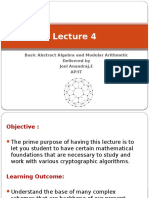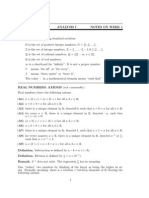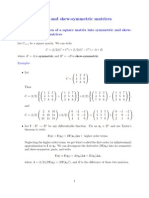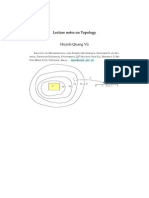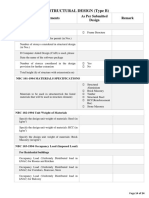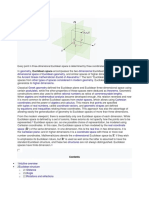Order-Theoretic Properties: Z Z Z Z Z
Order-Theoretic Properties: Z Z Z Z Z
Uploaded by
dwarika2006Copyright:
Available Formats
Order-Theoretic Properties: Z Z Z Z Z
Order-Theoretic Properties: Z Z Z Z Z
Uploaded by
dwarika2006Original Description:
Original Title
Copyright
Available Formats
Share this document
Did you find this document useful?
Is this content inappropriate?
Copyright:
Available Formats
Order-Theoretic Properties: Z Z Z Z Z
Order-Theoretic Properties: Z Z Z Z Z
Uploaded by
dwarika2006Copyright:
Available Formats
In the language of abstract algebra, the first five properties listed above for addition say that Z under
addition is an abelian group. As a group under addition, Z is a cyclic group, since every non-zero
integer can be written as a finite sum 1 + 1 + … + 1 or (−1) + (−1) + … + (−1). In fact, Z under
addition is the only infinite cyclic group, in the sense that any infinite cyclic group is isomorphic to Z.
The first four properties listed above for multiplication say that Z under multiplication is
a commutative monoid. However, not every integer has a multiplicative inverse; e.g., there is no
integer x such that 2x = 1, because the left hand side is even, while the right hand side is odd. This
means that Z under multiplication is not a group.
All the rules from the above property table, except for the last, taken together say that Z together
with addition and multiplication is a commutative ring with unity. It is the prototype of all objects of
such algebraic structure. Only those equalities of expressions are true in Z for all values of
variables, which are true in any unital commutative ring. Note that certain non-zero integers map
to zero in certain rings.
The lack of zero divisors in the integers (last property in the table) means that the commutative
ring Z is an integral domain.
The lack of multiplicative inverses, which is equivalent to the fact that Z is not closed under division,
means that Z is not a field. The smallest field containing the integers as a subring is the field
of rational numbers. The process of constructing the rationals from the integers can be mimicked to
form the field of fractions of any integral domain. And back, starting from an algebraic number
field (an extension of rational numbers), its ring of integers can be extracted, which includes Z as
its subring.
Although ordinary division is not defined on Z, the division "with remainder" is defined on them. It is
called Euclidean division and possesses the following important property: that is, given two
integers a and b with b ≠ 0, there exist unique integers q and r such that a = q × b + r and 0 ≤ r <
| b |, where | b | denotes the absolute value of b. The integer q is called the quotient and r is called
the remainder of the division of a by b. The Euclidean algorithm for computing greatest common
divisorsworks by a sequence of Euclidean divisions.
Again, in the language of abstract algebra, the above says that Z is a Euclidean domain. This implies
that Z is a principal ideal domain and any positive integer can be written as the products of primes in
an essentially unique way.[8] This is the fundamental theorem of arithmetic.
Order-theoretic properties[edit]
Z is a totally ordered set without upper or lower bound. The ordering of Z is given by: :… −3 < −2
< −1 < 0 < 1 < 2 < 3 < … An integer is positive if it is greater than zero and negative if it is less
than zero. Zero is defined as neither negative nor positive.
The ordering of integers is compatible with the algebraic operations in the following way:
1. if a < b and c < d, then a + c < b + d
2. if a < b and 0 < c, then ac < bc.
It follows that Z together with the above ordering is an ordered ring.
The integers are the only nontrivial totally ordered abelian group whose positive elements are well-
ordered.[9] This is equivalent to the statement that any Noetherianvaluation ring is either a field or
a discrete valuation ring.
Construction[edit]
Red points represent ordered pairs of natural numbers. Linked red points are equivalence classes representing
the blue integers at the end of the line.
In elementary school teaching, integers are often intuitively defined as the (positive) natural
numbers, zero, and the negations of the natural numbers. However, this style of definition leads to
many different cases (each arithmetic operation needs to be defined on each combination of types of
integer) and makes it tedious to prove that these operations obey the laws of arithmetic.[10] Therefore,
in modern set-theoretic mathematics a more abstract construction,[11] which allows one to define the
arithmetical operations without any case distinction, is often used instead.[12] The integers can thus
be formally constructed as the equivalence classes of ordered pairs of natural numbers (a,b).[13]
The intuition is that (a,b) stands for the result of subtracting b from a.[13] To confirm our expectation
that 1 − 2 and 4 − 5 denote the same number, we define an equivalence relation ~ on these pairs
with the following rule:
You might also like
- Ma103 DefinitionsDocument5 pagesMa103 DefinitionsLewis MacdonaldNo ratings yet
- Gerald Folland - Advanced CalculusDocument401 pagesGerald Folland - Advanced CalculusegemnNo ratings yet
- The Sparkcharts Algebra IDocument4 pagesThe Sparkcharts Algebra IMuhammad Fariz Mohamed Zain78% (9)
- IIT Prob PDFDocument154 pagesIIT Prob PDFrapsjadeNo ratings yet
- Krantz Real Analysis 4e Student Solutions ManualDocument103 pagesKrantz Real Analysis 4e Student Solutions ManualThiago Nobre100% (1)
- A Introduction To Finite Elements Based On Examples With Cast3mDocument51 pagesA Introduction To Finite Elements Based On Examples With Cast3mpemulung100% (1)
- Encyclopedia of Mathematical Physics Vol 1 A C Ed Fran Oise Et Al PDFDocument726 pagesEncyclopedia of Mathematical Physics Vol 1 A C Ed Fran Oise Et Al PDFASARSAT100% (5)
- Integer PDFDocument7 pagesInteger PDFeduliborioNo ratings yet
- Safari - 06-Aug-2018 at 6:55 PM PDFDocument1 pageSafari - 06-Aug-2018 at 6:55 PM PDFAnant SaraswatNo ratings yet
- Semiring PDFDocument8 pagesSemiring PDFmars0% (2)
- Grfnotes 1011Document47 pagesGrfnotes 1011Dr. V.Nirmala S& H ( Mathematics)No ratings yet
- Harrison 1994Document25 pagesHarrison 1994Ety SeptiatiNo ratings yet
- Complex Number: Mustansiriya UniversityDocument7 pagesComplex Number: Mustansiriya Universityzahraaraad918No ratings yet
- Complex NumberDocument32 pagesComplex NumbernagsidesNo ratings yet
- Notes 2Document117 pagesNotes 2Mustafiz AhmadNo ratings yet
- The Real Number System: PreliminariesDocument6 pagesThe Real Number System: PreliminariesCabriga JonathanNo ratings yet
- Chapter 7Document25 pagesChapter 7Susan JordanNo ratings yet
- Introduction To Finite FieldsDocument26 pagesIntroduction To Finite FieldsPetya ValchevaNo ratings yet
- Complex Numbers and StatsDocument41 pagesComplex Numbers and StatsbromikeseriesNo ratings yet
- Complex Numbers Edition 10Document44 pagesComplex Numbers Edition 10bromikeseriesNo ratings yet
- Final Exam - Dela Cruz, RegelleDocument11 pagesFinal Exam - Dela Cruz, RegelleDela Cruz, Sophia Alexisse O.No ratings yet
- Basic Abstract Algebra and Modular Arithmetic Delivered by Joel Anandraj.E Ap/ItDocument30 pagesBasic Abstract Algebra and Modular Arithmetic Delivered by Joel Anandraj.E Ap/ItjoelanandrajNo ratings yet
- Math Review HandoutDocument12 pagesMath Review HandoutDavid ReaverNo ratings yet
- Probabilty Notes at IITDocument154 pagesProbabilty Notes at IITrapsjadeNo ratings yet
- Public Key CryptoDocument17 pagesPublic Key CryptoMenuka PandeyNo ratings yet
- Lecture 3 CardinalityDocument4 pagesLecture 3 Cardinalitysourav kumar rayNo ratings yet
- Fields Besides The Real Numbers Math 130 Linear AlgebraDocument2 pagesFields Besides The Real Numbers Math 130 Linear AlgebraCody SageNo ratings yet
- Arbitrariness and ExistenceDocument10 pagesArbitrariness and ExistenceteacheryinyineduNo ratings yet
- CH 04Document38 pagesCH 04Musarat NazirNo ratings yet
- Rational Numbers As ExponentsDocument4 pagesRational Numbers As Exponentstutorciecle123No ratings yet
- Lecture Notes On Topology: Hu NH Quang VũDocument114 pagesLecture Notes On Topology: Hu NH Quang VũLe Duy HienNo ratings yet
- Lecture Notes by Stefan WanerDocument50 pagesLecture Notes by Stefan WanerYashodhan KarkareNo ratings yet
- Weil A.-Number Theory For BeginnersDocument37 pagesWeil A.-Number Theory For BeginnersAbhishek KumarNo ratings yet
- Abstract Algebra NotesDocument165 pagesAbstract Algebra Notesjoslu.alecebNo ratings yet
- Module-1: Divisibility and The Divisibility AlgorithmDocument21 pagesModule-1: Divisibility and The Divisibility Algorithmdigital loveNo ratings yet
- Math GRE w2015 Lecture8Document10 pagesMath GRE w2015 Lecture8AjjuNo ratings yet
- Lie AlgebrasDocument34 pagesLie AlgebrasAugusto CésarNo ratings yet
- KirchhoffDocument6 pagesKirchhoffshaheenghazeerNo ratings yet
- Real Analysis Lecture Notes 1Document6 pagesReal Analysis Lecture Notes 1MathsisCoolV1No ratings yet
- Math Week1 Notes GithubDocument5 pagesMath Week1 Notes GithubRohan BasuNo ratings yet
- Chapter 21Document6 pagesChapter 21manikannanp_ponNo ratings yet
- Subset - WikipediaDocument17 pagesSubset - WikipediaNaniNo ratings yet
- Mathematical Prerequisites: 1.1 Operations On Complex NumbersDocument6 pagesMathematical Prerequisites: 1.1 Operations On Complex NumbersDennis Mads MakhandiaNo ratings yet
- Binomial TheoremDocument9 pagesBinomial TheoremjOhNyDoN21No ratings yet
- Giáo Trình TopoDocument154 pagesGiáo Trình Toposang_inequalityNo ratings yet
- Ug Math 2011Document3 pagesUg Math 2011Rama SubramaniamNo ratings yet
- Ring Homomorphisms: DefinitionDocument4 pagesRing Homomorphisms: DefinitionTom DavisNo ratings yet
- Discret Math Unit 4-6Document8 pagesDiscret Math Unit 4-6Erick InfanteNo ratings yet
- Introduction To Group TheoryDocument11 pagesIntroduction To Group Theorydelia albarracinNo ratings yet
- 11 Division Mod NDocument20 pages11 Division Mod NMayo CrowsNo ratings yet
- Cholesky Decomposition: Viewed Separately Opened Into A New SheetDocument7 pagesCholesky Decomposition: Viewed Separately Opened Into A New SheetKaren KoleNo ratings yet
- On An Exotic Topology of The Integers: Rezs o L. Lovas Istv An Mez o 2010Document6 pagesOn An Exotic Topology of The Integers: Rezs o L. Lovas Istv An Mez o 2010whateveranythingNo ratings yet
- Discrete Math and Probability TheoryDocument133 pagesDiscrete Math and Probability TheoryninjatronNo ratings yet
- AhjnbDocument7 pagesAhjnbWorse To Worst SatittamajitraNo ratings yet
- Confined Masonry NetworkDocument11 pagesConfined Masonry Networkdwarika2006No ratings yet
- Engineering Failure Analysis: Hongling Sun, Aiping Zhang, Jiangtao CaoDocument7 pagesEngineering Failure Analysis: Hongling Sun, Aiping Zhang, Jiangtao Caodwarika2006No ratings yet
- Precast Concrete Is A Construction Product Produced by Casting Concrete in A ReusableDocument2 pagesPrecast Concrete Is A Construction Product Produced by Casting Concrete in A Reusabledwarika2006No ratings yet
- Class B (Residential RCC With Is Code) Structural ChecklistDocument6 pagesClass B (Residential RCC With Is Code) Structural Checklistdwarika2006No ratings yet
- Driven Foundations: Pile Foundation SystemsDocument3 pagesDriven Foundations: Pile Foundation Systemsdwarika2006No ratings yet
- Radioactive Decay (Also Known As Nuclear Decay, Radioactivity or Nuclear Radiation) Is TheDocument2 pagesRadioactive Decay (Also Known As Nuclear Decay, Radioactivity or Nuclear Radiation) Is Thedwarika2006No ratings yet
- Quality Manual For Civil Works in Building - Planning IBC - 13 - 2012 - IBCDocument8 pagesQuality Manual For Civil Works in Building - Planning IBC - 13 - 2012 - IBCdwarika200650% (2)
- DiadacticDocument2 pagesDiadacticdwarika2006No ratings yet
- French Nobility: François de Castagnère, Abbé de ChâteauneufDocument4 pagesFrench Nobility: François de Castagnère, Abbé de Châteauneufdwarika2006No ratings yet
- Every Point in Three-Dimensional Euclidean Space Is Determined by Three CoordinatesDocument2 pagesEvery Point in Three-Dimensional Euclidean Space Is Determined by Three Coordinatesdwarika2006No ratings yet
- Methodology: Petrology (From TheDocument2 pagesMethodology: Petrology (From Thedwarika2006No ratings yet
- Solukhumbu and KhotangDocument12 pagesSolukhumbu and Khotangdwarika2006No ratings yet
- Habitat: Sochi RussiaDocument3 pagesHabitat: Sochi Russiadwarika2006No ratings yet
- Continuum MechanicsDocument4 pagesContinuum Mechanicsdwarika2006No ratings yet
- Table 2 SP16Document1 pageTable 2 SP16dwarika2006100% (5)
- French Greek Helix French Physicist André-Marie Ampère Physics Metallic Magnetic Field Electric Current Electromagnet InductorDocument1 pageFrench Greek Helix French Physicist André-Marie Ampère Physics Metallic Magnetic Field Electric Current Electromagnet Inductordwarika2006No ratings yet
- Cauchy Binet FormulaDocument4 pagesCauchy Binet Formuladwarika2006No ratings yet
- Abstract AlgebraDocument3 pagesAbstract Algebradwarika2006No ratings yet
- Science: Albatrosses, of The BiologicalDocument5 pagesScience: Albatrosses, of The Biologicaldwarika2006No ratings yet
- Kronecker DeltaDocument5 pagesKronecker Deltadwarika2006No ratings yet
- Types of Seismic WaveDocument4 pagesTypes of Seismic Wavedwarika2006No ratings yet
- China Japan: Hamburg SteaksDocument3 pagesChina Japan: Hamburg Steaksdwarika2006No ratings yet
- Thermal DOD: Canon Hewlett-Packard Lexmark ThermalDocument3 pagesThermal DOD: Canon Hewlett-Packard Lexmark Thermaldwarika2006No ratings yet
- IranDocument3 pagesIrandwarika2006No ratings yet
- Tajiki Dari: Persian (Document2 pagesTajiki Dari: Persian (dwarika2006No ratings yet
- ChristianityDocument3 pagesChristianitydwarika2006No ratings yet
- Review of Basic Field Equations: Strain-Displacement RelationsDocument14 pagesReview of Basic Field Equations: Strain-Displacement RelationsajpsalisonNo ratings yet
- MSC Maths Syllabus IIT GuwahatiDocument51 pagesMSC Maths Syllabus IIT Guwahatimanasdutta3495No ratings yet
- Practice Set-8 From Ncert CH 1 To 07Document3 pagesPractice Set-8 From Ncert CH 1 To 07chauhanritika921No ratings yet
- Abraham Adrian Albert by Nathan JacobsonDocument26 pagesAbraham Adrian Albert by Nathan JacobsonJust BarryNo ratings yet
- Mesleki İngilizce: Elif Yüceel 190444025 İlköğretim Matematik ÖğretmenliğiDocument10 pagesMesleki İngilizce: Elif Yüceel 190444025 İlköğretim Matematik Öğretmenliğiapi-618267797No ratings yet
- Analytical Modeling of Magnetic Field in Surface Mounted Permanent Magnet Tubular Linear MachinesDocument17 pagesAnalytical Modeling of Magnetic Field in Surface Mounted Permanent Magnet Tubular Linear Machinessandeepsandy07No ratings yet
- Mathematics (MATH)Document6 pagesMathematics (MATH)elekojshNo ratings yet
- Ansoft HFSS - Technical Notes Topics: Technical NotesDocument62 pagesAnsoft HFSS - Technical Notes Topics: Technical NotesAppleWangAceNo ratings yet
- Algebric Methods For MOdeling and Design in Control PDFDocument154 pagesAlgebric Methods For MOdeling and Design in Control PDFpi minNo ratings yet
- Basic MCQs of Computer ScienceDocument113 pagesBasic MCQs of Computer ScienceDaas ANo ratings yet
- Linear Algebra - Binary OperationsDocument15 pagesLinear Algebra - Binary OperationsArivanandam RNo ratings yet
- Chuyên Đề Thỉnh Giảng 2023 - Số HọcDocument5 pagesChuyên Đề Thỉnh Giảng 2023 - Số Họcminhpropvp1023No ratings yet
- Resonant Cavity Design Using The Finite Element MethodDocument3 pagesResonant Cavity Design Using The Finite Element MethodbaymanNo ratings yet
- OpenFOAM A C++ Library For Complex Physics SimulationsDocument20 pagesOpenFOAM A C++ Library For Complex Physics SimulationsAghajaniNo ratings yet
- Unit 1 - Introduction & Number Theory: Dr.S.Kalaivani Assistant Professor/ Dept. of CSE IrttDocument87 pagesUnit 1 - Introduction & Number Theory: Dr.S.Kalaivani Assistant Professor/ Dept. of CSE IrttRishikaa RamNo ratings yet
- Pure Mathematics 2017Document3 pagesPure Mathematics 2017Naeem RehmanNo ratings yet
- MM 1000 (2014) Introduction To Micromine (2014-07)Document316 pagesMM 1000 (2014) Introduction To Micromine (2014-07)Linggar KumaraNo ratings yet
- APSC Optional Paper Syllabus MathematicsDocument1 pageAPSC Optional Paper Syllabus MathematicsmanashNo ratings yet
- Neukirch 3Document196 pagesNeukirch 3LukeNo ratings yet
- Qise Qis College of Engineering & Technology:: Ongole (Autonomous)Document21 pagesQise Qis College of Engineering & Technology:: Ongole (Autonomous)Venkatesh BanalaNo ratings yet
- DISCRETE MATHEMATICS AND ITS APPLICATIONS Series EditorDocument602 pagesDISCRETE MATHEMATICS AND ITS APPLICATIONS Series EditorjerryNo ratings yet
- Course Guide Math 17-bDocument3 pagesCourse Guide Math 17-bJames Albert AquinoNo ratings yet
- MagNet - GettingStartedDocument23 pagesMagNet - GettingStartedumairmoughalNo ratings yet
- Multivariable Calculus: Don ShimamotoDocument5 pagesMultivariable Calculus: Don ShimamotoSubham KarmakarNo ratings yet
- Maddaygrothendieck PDFDocument20 pagesMaddaygrothendieck PDFWalter Andrés Páez GaviriaNo ratings yet
- 1 VECTOR SPACES AND SUBSPACES - Additional ActivityDocument7 pages1 VECTOR SPACES AND SUBSPACES - Additional ActivityCris JoseNo ratings yet
- Course-8 (B) Mathematics (Part-1)Document116 pagesCourse-8 (B) Mathematics (Part-1)sharmin kaziNo ratings yet
- Model Theoretic Algebra - JansenDocument460 pagesModel Theoretic Algebra - Jansenatv77890No ratings yet






















